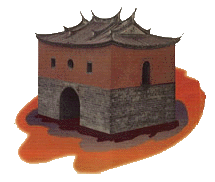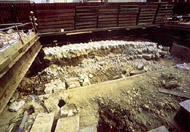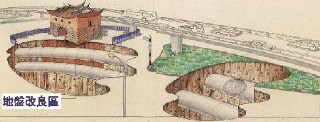Historic Preservation
Preserving Our Cultural Heritage A Brief History of Taipei Taipei was founded in the 8th year of the Guang Xu Emperor's reign (1882) during the Qing dynasty and was completed within three years. It became the strongest fortress in Taiwan's history because of its emphasis on strong construction materials. The city wall-- located along modern day Zhongxiao West Road, Zhongshan South Road, Aiguo West Road and Zhonghua Road -- was over 5,000 meters long and about 5 meters high. In the development of modern Taipei, the old city enclosed by the wall had important value and significance. The city wall originally had five gates. But most of the wall was demolished during the Japanese colonial period, and today only four gates remain: the North Gate, East Gate, South Gate and Little South Gate. Preserving Relics of the Old City Wall The North Gate Securing the North Gate Project CN253B, which stretched from Ximending to the Hilton Hotel (now Caesar Park Hotel), included two shield tunnels passing the north section of Zhonghua Road at different elevations. This is where the North Gate is situated. Since the upper tunnel came very close to the gate, preservation of this historic relic became a major concern. The Taipei City government therefore formed a professional preservation team, and, based on the team's recommendation, the Central District Project Office of DORTS worked with the contractor to improve the capacity of the underground soil in the area by high-pressure jet grouting. This transformed the soil between the base of the gate and the upper shield tunnel into a solid soil block, so that the tunnel could proceed without disturbing the soil beneath the gate. Upper Shield Tunnel Passes Beneath the North Gate 
 At the end of 1993, relics of the Taipei City Wall, including foundations, an artillery battery and water gates, were discovered near the intersections of Zhongxiao West Road with Guanqian Road and Huaining Street during excavation work for the CN253B underground mall. Work was immediately halted, and an investigation conducted by historic preservation experts ensued. The unearthed relics were secured and a team of specialists was set up to arrange further investigation, preservation, relocation, and exhibition.
At the end of 1993, relics of the Taipei City Wall, including foundations, an artillery battery and water gates, were discovered near the intersections of Zhongxiao West Road with Guanqian Road and Huaining Street during excavation work for the CN253B underground mall. Work was immediately halted, and an investigation conducted by historic preservation experts ensued. The unearthed relics were secured and a team of specialists was set up to arrange further investigation, preservation, relocation, and exhibition.  The North Gate, a Grade 1 historic site dating from 1884, is situated at the intersection of Zhongxiao West Road and Zhonghua Road. It is one of four old city gates remaining in Taipei and is the only one that is preserved in its original form. The gate remained unchanged for more than a century as the city prospered and grew. In 1996, a shield tunnel associated with Project CN253B was scheduled to pass beneath this gate, presenting a major challenge for DORTS as it sought to continue construction while preserving an important part of the city's heritage.
The North Gate, a Grade 1 historic site dating from 1884, is situated at the intersection of Zhongxiao West Road and Zhonghua Road. It is one of four old city gates remaining in Taipei and is the only one that is preserved in its original form. The gate remained unchanged for more than a century as the city prospered and grew. In 1996, a shield tunnel associated with Project CN253B was scheduled to pass beneath this gate, presenting a major challenge for DORTS as it sought to continue construction while preserving an important part of the city's heritage.  On January 4, 1996, excavation of the upper shield tunnel, which was less than 2 meters above the lower shield tunnel, reached the North Gate area. Engineers monitored the process around-the-clock. Difficulties were encountered due to excessive strength of the soil block, and the curved alignment made the situation even more complicated. The shield tunneling machine finally passed out of the area of influence on January 29, without any damage to the gate.
On January 4, 1996, excavation of the upper shield tunnel, which was less than 2 meters above the lower shield tunnel, reached the North Gate area. Engineers monitored the process around-the-clock. Difficulties were encountered due to excessive strength of the soil block, and the curved alignment made the situation even more complicated. The shield tunneling machine finally passed out of the area of influence on January 29, without any damage to the gate.

![Taiwan.gov.tw [ open a new window]](/images/egov.png)
